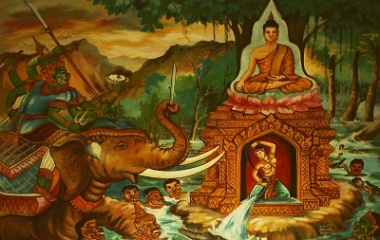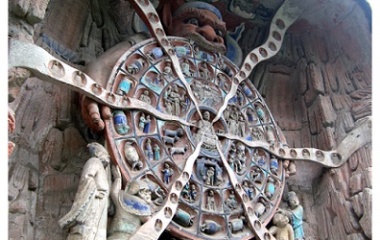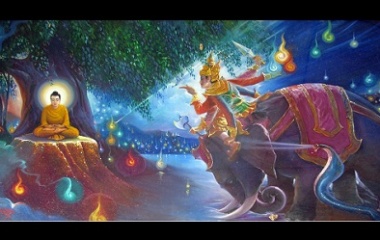Under the titles “Prince of Darkness,” “Tempter,” “Lord of Death,” and “Evil One,” Mara weaves his way through Buddhist scripture, wreaking havoc and sowing bad karma where he goes. This god is hell-bent on obstructing enlightenment, and with his boundless influence over the lives and hearts of men, he is very good at achieving his goal.
What Is Mara?
Mara is a demonic god who runs rampant in Kāmadhātu, the “Desire Realm” of Buddhist cosmography. He attempts to corrupt the other inhabitants of Kāmadhātu, including animals, humans, and demigods, by tempting them with desire and instilling them with fear.
Characteristics
Physical Description
Early followers of Buddhism believed that Mara had both a metaphorical and literal existence, which allowed him to take physical form in Kāmadhātu. Ancient drawings show Mara as a fat-bodied creature with either blue-green or angry red skin. Like most wrathful gods in Indian culture, he usually has three eyes and may have six arms. A crown of human skulls encircles his head, and he is often seen riding an elephant or in the company of serpents.
Most contemporary Buddhists believe that Mara only has a metaphorical existence. Although he doesn’t take a physical form, he is nevertheless real and must be combatted.
Special Abilities
Mara’s greatest power is his influence over the other inhabitants of the Desire Realm. Not only can he summon other demons to him whenever he pleases, he can turn good men and women into tools as well. With clever lies and cunning truths, he succeeds at filling hearts with greed, lust, anger, jealousy, confusion, fear, and depression.
Mara can also disguise himself by taking the form of other people. He can appear as someone you hate, someone you love, someone you fear, or someone you trust, and twist your mind with false messages delivered by friend or foe.
All of Mara’s deviance is designed to inspire the people of Kāmadhātu to accumulate bad karma, so that they are unable to break their karmic cycle and escape the Desire Realm, where they exist under the shadow of his influence.
Family
Mara’s daughters, each of whom represent an undesirable emotion, are his most powerful allies. He uses the beautiful girls as weapons to plant negative feelings in the people of Kāmadhātu and inspire them to accumulate bad karma.
Different texts assign different numbers of daughters to the Prince of Darkness. Most often, he has three daughters: Tanhā (craving), Arati (aversion, discontentment), and Raga (attachment, desire, greed, passion).
In other texts, he has 10 daughters, sometimes called the Ten Chief Sins. They are Sakkaya-ditthi (pride, conceit), Vicikiccha (skepticism, doubt), Silabbata Paramasa (devotion to wrong rituals), Kama-raga (sensuality, desire), Patigha (ill will), Rupa-raga (attachment to the Form Realm), Arupa-raga (attachment to the Formless Realm), Mana (superiority), Uddhacca (restlessness, turmoil), and Avija (ignorance).
Cultural Representation
Origin
Neither the concept of Mara nor his name are Buddhist inventions. Prior to Buddhism, Hindu texts from the Vedic Period contained a god with the same name, who represented both sexuality and death. Even earlier Hindu texts contain numerous yakshas, nature spirits who resemble Mara in their powers, habits, and goals.
It’s clear from early Buddhist texts that the Evil One has been a player in Buddhist lore from the beginning. He appears in some of the earliest scriptures, written about a century after Buddha’s death, and Buddha himself talks to his disciples about Mara.
Famous Stories
Mara is a prominent character in Buddhist scripture, with two sections of scripture, the Mara-Samyutta and the Bhikkhuni-Samyutta dedicated to recording his exploits.
Almost all Buddhists are familiar with the Tempter’s most infamous attack, which he launched against Siddhartha Guatama when the sage was on the brink of enlightenment.
Sensing that Siddhartha would soon break the fetters of the Desire Realm and obtain a pure and boundless knowledge, which could be used to help others reach enlightenment, Mara set out to disturb Siddhartha’s meditation. He found the soon-to-be-Buddha sitting under the Bhodi Tree, nearly starved but filled with a glorious inner peace. Of course, this wouldn’t do. The Tempter immediately began filling Siddhartha’s ears with whispers of the grand kingdom he could establish, to glorify and better mankind. Siddhartha recognized that these whispers were empty and ignored them. Next, Mara rebuked Buddha for abandoning the duties of his religion, social class, and even his position as a father and husband. Buddha shrugged these remarks off too.
Seeing that his own wiles were no match for Siddhartha’s inner focus, Mara decided to call upon his allies. He summoned an army of terrible demons to him, and they fired a volley of arrows at the resting Siddharta. The man never flinched as the arrows sped towards him, and just before they struck, the arrows were transformed into flowers that showered around him. Buddha then reached out to the earth for help, and a flood washed the demonic hoard away.
Now, the Evil One was at the end of his tether. He summoned his own daughters, Tanhā, Arati, and Raga, to help him loosen Siddhartha’s grip on enlightenment. The daughters danced before Siddhartha and coaxed him with all their sensual charms to come back into the Desire Realm. Siddhartha, however, was unaffected.
Mara dismissed his daughters and took one last stab at Siddhartha, this time resorting back to his own genius for corruption and temptation. He began mocking Siddhartha, telling him that his attempts to reach enlightenment were all vain, since no one was there to witness the achievement. In response, Siddhartha rested one hand on the earth, proclaiming that the earth itself would be his witness. The earth trembled in response, and the Prince of Darkness flew off in a rage, knowing he had been bested.
Explanation of the Myth
Perhaps there was never a wrathful, six-armed demon riding an elephant through the peaceful Indian countryside and leaving bad karma in his wake—but that doesn’t mean Mara doesn’t exist.
Many modern Buddhists have come to understand Mara as a psychological phenomenon. Mara is a conglomerate of all the distractions that Buddhists must overcome to build good karma and reach enlightenment. Indeed, when you try to delve deep into a meditative state, it might feel like you are battling a swarm of demons—or one demonic god—along the way.
Mara has also been interpreted as a metaphor for samsara, the cycle of death and re-birth which Buddhists are trying to escape. Mara is considered a god of desire and sensuality as well as a god of death. He creates and destroys life over and over again, thus creating samsara. When the Buddha defeated Mara and when he urges his followers to oppose Mara, he may actually be calling them to escape samsara.
Deep-rooted cultural customs may have driven early Buddhists to anthropomorphize Mara, as it was easier for them to rationalize Mara’s power as the power of a rampant god than a psychological phenomenon. The construct of gods was more familiar than the construct of the human psyche.










